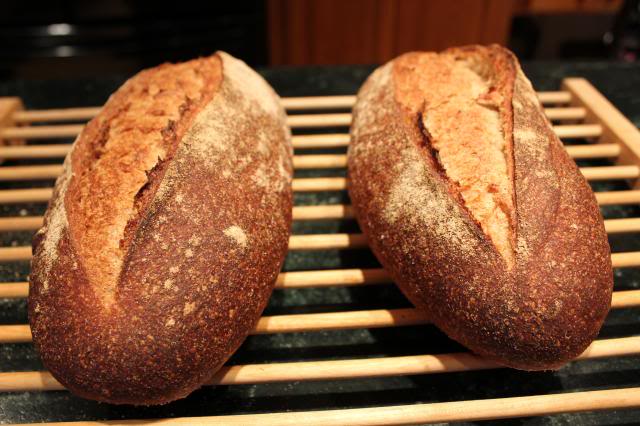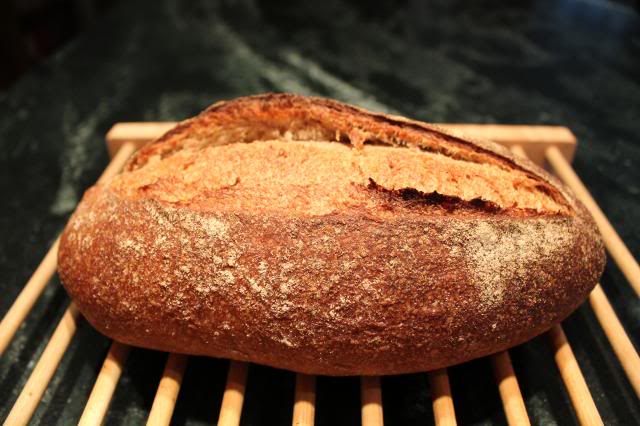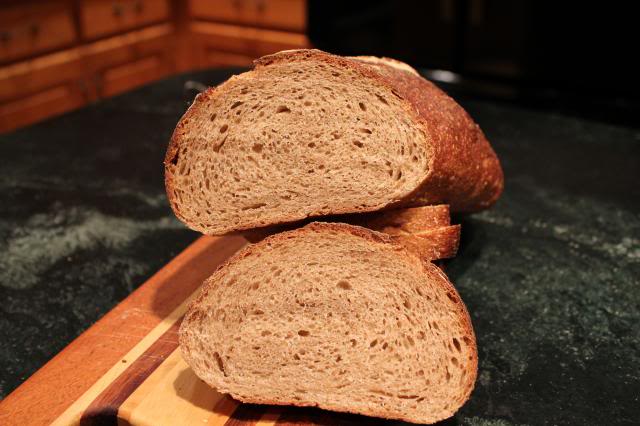
Hamelman's Pain au Levain

Maybe this should be called Hamelman's Pain au Levain, mostly, because there were a couple of small excursions from the formula presented in Hamelman's Bread, 2nd Edition.
Having enjoyed several days' worth of the Rustic Pumpernickel from Inside the Jewish Bakery, I was ready for a change of pace. My starter was in need of a good feeding, so I have it a healthy dose of rye flour and water and left it to its own devices overnight. The next morning, it was ripe and ready for action. Gotta love these warm summertime temperatures. At this point, I had no real plan, just a vague notion of something not-pumpernickel. Remembering that I hadn't baked from Hamelman's book for a while, I started leafing leafing through it and came across the Pain au Levain bread. Just the ticket, since it has a small portion of rye flour in it.
Since I had fed my starter with rye flour, I calculated that I would have a bit more rye than the formula called for even if I didn't add any in the final dough. No problem. It would still be good. And, the bread flour that I used was the Great River Milling Unbleached Wheat Bread Flour which still contains 20% of the bran. Again, no problem; just more flavor. The other thing about the GRM flour is its protein content: 14%. That's much higher than any French-style flour's protein content. I mixed the levain, covered it, and left it to ferment at room temperature. It was ready for use about 3:30 in the afternoon.
Hamelman assumes a room temperature bulk fermentation and final fermentation. As I looked at the clock, and at the instructions, I decided that I really didn't want to stay up late. That led to the other deviation: a decision to retard the dough during its bulk ferment. The rest of the process was pretty much by the book. The flour and water were mixed by hand and allowed 60 minutes to autolyse. Then the levain was mixed in. That was a bit trickier, because the dough was stiffer than the levain, but the dough came together after the initial goopy phase and got even better after the salt was added. The texture was still fairly firm, so I worked in another 3-4% of water. The absorptive capability of the flour meant that I still didn't have a soft dough but it felt quite moist and tacky so I called it good enough. That turned out to be a good decision.
I allowed the dough an hour of bulk fermentation at room temperature, then put it into the refrigerator until the following afternoon, almost 20 hours later. The dough hadn't doubled in volume, so I gave it an hour or so to warm up somewhat, then shaped it into two batards. Each was allowed to proof on a piece of parchment paper, covered with plastic. The dough was firm enough that I did not provide side support for it. Indeed, most of the doubling was in the upward direction, not the horizontal direction, which is pretty unusual for a sourdough. When it had grown by perhaps 80%, I preheated the oven with a stone and a steam pan. After the oven reached temperature, I boiled water and poured it into the steam pan. The loaves were then slashed and placed on the stone to bake as directed.
During the bake, the loaves continued to expand upwards, but more sideways than they had during the final fermentation. The scores opened nicely and gave a good ear.


The crumb is less open than might be expected for this style of bread and this level of hydration. I think that the amount of kneading that was required to incorporate the levain had an effect, as did the high protein content of the bread flour. I'm not at all unhappy, since the primary use for the bread is in sandwiches. That means I don't have mayonnaise or mustard dripping into my lap while eating.

The crumb is very moist, probably attributable in part to the rye flour's moisture-grabbing traits, plus the additional water that I added to offset the dough's stiffness. More would have been too much, so I am glad that I stopped when I did with the extra water. The color is a bit darker because of the additional bran content not usually seen in a bread flour. The crust, which was initially quite hard, has softened considerably as the moisture within the loaf has redistributed. The flavor is excellent, combining wheat and rye notes with a gentle sourdough tang and the toasty/nutty/caramel notes from the crust. My hat is off to Mr. Hamelman for devising such an enjoyable bread.
Paul


Comments
bread to me. Great crust the crumb is what one would expect with whole rye and a bran rich wheat flour like yours. That bread flour sounds like it would be perfect for so many kinds of breads. The flavor it provides easily compensates for large holes that have no taste whatsoever.
It is a fine loaf of bread that has to taste great.
Happy baking
And it's the perfect color to delight a brownman. The bread flour is very good but rather pricey, so I doubt that I will be buying any more. The high protein content makes it a great substitute for first clear, albeit a bit lighter in color, in rye breads. Hmm, I should have made bagels with it; I'm not sure there's enough left for a batch.
Paul
Nice looking tasty loaf Paul.
Especially when you can ring both the "pretty" and "tastes good" bells at the same time, as you often do.
Paul
When I started baking bread in earnest,I didn't know I would have to become adept at managing environmental conditions but it's just part of the fun of living in KS. The forecast for next week looks like a good time to bake until the freezers burst.
The pear tomatoes are coming on strong, so my wife made a batch of tomato sauce this morning. We've put a bunch of blueberries in the freezer, too. So, no chance to stuff it with bread, even though the weather does look very favorable, indeed.
Paul
Those loaves look wonderful. The crumb was probably more dense due to the flours you used - more bran and more water absorption. But, as you said, that is better for drippy spreads.
David
I'm very pleased with this bake. You are very much on target about the flours. And about the performance in sandwiches.
Paul
Hey Paul. I really like this...the crumb almost looks like a Jewish Deli Rye. This loaf screams sandwiches!
I bet you will be having some amazing ones in the next week. I am having sandwiches for dinner tonight with fresh SD, but now I am jealous....I want THAT loaf!
John
SD for PaL, mon ami? Merveilleux, non?
We went the salads route for dinner tonight, so you didn't miss anything on the bread front by not being here.
Paul
Hi Paul,
The scoring and bloom of these loaves really caught my attention - lovely!
:^) breadsong
There was a bit of the happy dance going on in the kitchen when I saw how they opened up.
Paul
Those are lovely loaves. We often eat sandwiches for dinner and I can appreciate your lovely crumb....so does my lap. I can just see the happy dance :) c
I'm terribly biased, but I think that they look good, too! :-)
And yes, they work very well for their intended purpose.
Paul
Although that is quite a departure from Hamelman's Pain au levain in terms of flours used, your version has proven that with good flours and keen eyes, all is possible. You have crafted a superior bread in flavor than Hamleman's , i'm sure.
Lovely!
-Khalid
I hope to have the pleasure of tasting some of Mr. Hamelman's work someday. Until then, this will have to suffice for my tastebuds. Being able to turn out a pleasing bread following (mostly) his formula and instructions is very gratifying.
Paul
i would be dancing too, having such beautiful loaves :)
evon
So much of what you produce is absolutely lovely.
Paul